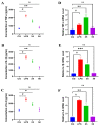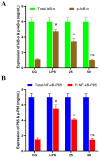Ginsenoside Rb1 Mitigates Escherichia coli Lipopolysaccharide-Induced Endometritis through TLR4-Mediated NF-κB Pathway
- PMID: 34885671
- PMCID: PMC8659231
- DOI: 10.3390/molecules26237089
Ginsenoside Rb1 Mitigates Escherichia coli Lipopolysaccharide-Induced Endometritis through TLR4-Mediated NF-κB Pathway
Abstract
Endometritis is the inflammatory response of the endometrial lining of the uterus and is associated with low conception rates, early embryonic mortality, and prolonged inter-calving intervals, and thus poses huge economic losses to the dairy industry worldwide. Ginsenoside Rb1 (GnRb1) is a natural compound obtained from the roots of Panax ginseng, having several pharmacological and biological properties. However, the anti-inflammatory properties of GnRb1 in lipopolysaccharide (LPS)-challenged endometritis through the TLR4-mediated NF-κB signaling pathway has not yet been researched. This study was planned to evaluate the mechanisms of how GnRb1 rescues LPS-induced endometritis. In the present research, histopathological findings revealed that GnRb1 ameliorated LPS-triggered uterine injury. The ELISA and RT-qPCR assay findings indicated that GnRb1 suppressed the expression level of pro-inflammatory molecules (TNF-α, IL-1β and IL-6) and boosted the level of anti-inflammatory (IL-10) cytokine. Furthermore, the molecular study suggested that GnRb1 attenuated TLR4-mediated NF-κB signaling. The results demonstrated the therapeutic efficacy of GnRb1 in the mouse model of LPS-triggered endometritis via the inhibition of the TLR4-associated NF-κB pathway. Taken together, this study provides a baseline for the protective effect of GnRb1 to treat endometritis in both humans and animals.
Keywords: Ginsenoside Rb1; NF-κB pathway; TLR4; endometritis; lipopolysaccharide.
Conflict of interest statement
The authors declare no conflict of interest.
Figures








References
-
- Zhang H., Wu Z.M., Yang Y.P., Shaukat A., Yang J., Guo Y.F., Zhang T., Zhu X.Y., Qiu J.X., Deng G.Z., et al. Catalpol ameliorates LPS-induced endometritis by inhibiting inflammation and TLR4/NF-kappaB signaling. J. Zhejiang Univ. Sci. B. 2019;20:816–827. doi: 10.1631/jzus.B1900071. - DOI - PMC - PubMed
MeSH terms
Substances
Grants and funding
LinkOut - more resources
Full Text Sources
Medical
Miscellaneous

